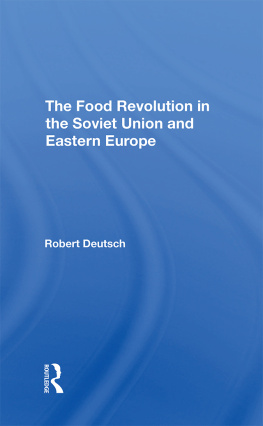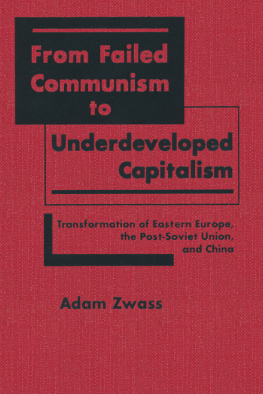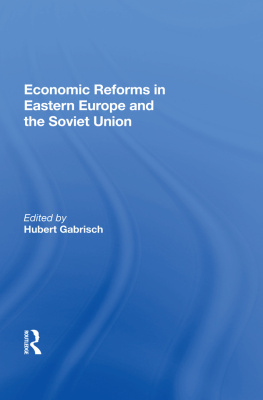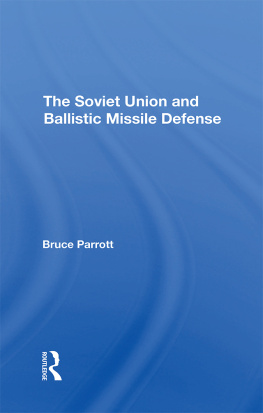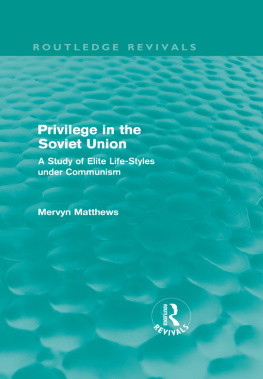A Case Study of a Soviet Republic
Other Titles in This Series
Hungary: An Economic Geography, Gyrgy Enyed
The Future of Agriculture in the Soviet Union and Eastern Europe: The 1976-1980 Five-Year Plans, edited by Roy D. Laird, Joseph Hajda, and Betty A. Laird.
Population and Migration Trends in Eastern Europe, edited by Huey Louis Kostanick
The German Democratic Republic: A Developed Socialist Society, edited by Lyman H. Legters
Yugoslavia After Tito: Scenarios and Implications, Gavriel D. Ra'anan
The Liberated Female: Life, Work, and Sex in Socialist Hungary, Ivan Volgyes and Nancy Volgyes
The Soviet Agrarian Debate: A Controversy in Social Science, 1923-1929, Susan Gross Solomon
Perspectives for Change in Communist Societies, edited by Teresa Rakowska-Harmstone
Westview Special Studies on the Soviet Union and Eastern Europe
A Case Study of a Soviet Republic: The Estonian SSR
edited by Tnu Parming and Elmar Jrvesoo
The Estonian SSR is the most industrially advanced and urbanized of the Soviet republics and also, perhaps logically, has the most Western life style and the highest standard of living. This in-depth study of the Estonian SSR not only describes the current Estonian scene, but also analyzes the postwar Soviet years, concentrating on the factors that have led Estonia to its present status. All chapters were written especially for this volume by subject specialists fluent in Estonian. In sum, it is the most detailed and comprehensive study of a Soviet republic available in English, and it supports the editors' argument that analysts' traditional preoccupation with events and decisions at the political center of the Soviet Union has been unsatisfactory for a thorough understanding of the country: much more attention must be given to the individual union republics.
Tnu Parming holds a doctorate in sociology from Yale University and is now assistant professor of sociology at the University of Maryland. Elmar Jrvesoo obtained his doctorate in agrarian economics from the Friedrich Wilhelm University in Berlin, He is currently professor of agrarian marketing at the University of Massachusetts.
Published with the cooperation of the Estonian Learned Society in America.
A Case Study of a Soviet Republic
The Estonian SSR
edited by
Tnu Parming and Elmar Jrvesoo
Foreword by Edward Allworth
First publishing 1978 by Westview Press, Inc.
Published 2018 by Routledge
52 Vanderbilt Avenue, New York, NY 10017
2 Park Square, Milton Park, Abingdon, Oxon OX14 4RN
Routledge is an imprint of the Taylor & Francis Group, an informa business
Copyright 1978 Taylor & Francis
All rights reserved. No part of this book may be reprinted or reproduced or utilised in any form or by any electronic, mechanical, or other means, now known or hereafter invented, including photocopying and recording, or in any information storage or retrieval system, without permission in writing from the publishers.
Notice:
Product or corporate names may be trademarks or registered trademarks, and are used only for identification and explanation without intent to infringe.
Library of Congress Cataloging in Publication Data
Main entry under title:
A Case Study of a Soviet Republic: The Estonian S. S. R.
(Westview special studies on the Soviet Union and Eastern Europe)
1. Estonia. I. Parming, Tnu. II. Jrvesoo, Elmar. III. Series.
DK511.E5E7777 947'.41 77-671
ISBN 0-89158-247-9
ISBN 13: 978-0-367-01783-5 (hbk)
Contents
, Edward Allworth
, Tnu Parming and Elmar Jrvesoo
, Tnu Parming
, Rein Taagepera
, Jaan Pennar
, Elmar Jrvesoo
, Vello Salo
, Reet Nurmberg-Howell
, George Kurman
, Mardi Valgeme
, Gustav Rnk
, Teodor Knnapas and Elmar Jrvesoo
, Heino Susi
, Rein Trn
, Valdar Oinas
Edward Allworth
A delicate but portentous kind of group tension grows in the multiethnic Soviet Union today. It is marked by imperfect interaction and partial disconnection between various eponymous nationalities and the Soviet socialist republics (SSRs) named for them. With each passing decade, it becomes increasingly obvious that territorial and demographic discrepancies set off nationality from SSR in almost every case. This trend may signal the end of the formative stage and the start of a degenerative stage in the development of the SSRs. Those horizontal, spatial imperfections that reveal the misalignment between the body of an eponymous ethnic group and the SSR "garment" designed for it are accentuated by additional gaps.
Neither constitutional nor other statutory guarantees ensure that any Soviet nationality will be provided with an SSR of its own or an appropriate lesser unit. (Consider the homeless Soviet Germans, Jews, and Poles, each of whom numbered far more than a million persons in 1970.) Should such new administrative units be created, they would not necessarily bear ethnic names. Several Soviet subunits, in addition to the ordinary krais, oblasts, and raions, in fact already carry ethnically neutral designations. Yet the Daghistan Autonomous SSR, the Gorno-Badakhshan Autonomous Oblast, and the like are populated densely by one or more long-defined nationalities speaking distinct languages.
These arrangements insulate a nationality from precise contact or identification with the pertinent territorial-administrative structure of the state. This hiatus significantly differentiates the group further from the people of a true nation state. More pointed still are the deprivations related to the absence of a nationality-oriented government or an ethnic political party at any level. Formally, local administration in the USSRorganized as it is around the subunits mentionedbecomes SSR government, ASSR administration, and on down the unit hierarchy, but never government of and for an ethnic group. Rather than representing some single nationality, the branches of the dominant Soviet political force, the Communist party, always refer to geographical areas, not to SSRs or nationality groups.
Because such distancing affects every nationality-oriented SSR, to what extent can it be said that studying one Soviet socialist republic is the equivalent of scrutinizing them all? The matter of comparability among the fourteen nationality SSRs (excluding the Russian SFSR) is raised by implication in conjunction with any serious investigation of the developments in a single SSR. That question, in turn, inevitably poses a further basic problem: To what extent can the examination of any SSR be regarded as an inquiry into the life of its eponymous nationality?
The detailed account offered in this volume presents, in parallel sections, the evolution of the artistic, cultural, economic, social, and political life of the Estonian SSR. In examining the degree to which the coincidence between SSR and nationality holds true for Soviet Estonia in the 1970s, this book lays a foundation upon which an answer may be worked out to this vital question.
Recent statistical compilations ( Narodnoe khoziaistvo, 1974; Katz et al., 1975:441-465) have ranked the ESSR high among SSRs in certain economic and social-cultural indicators but below the majority in political vitality and demographic factors other than concentration and urbanization. Thus, while the impressive material and other external achievements of the ESSR are shared by few other republics in the Soviet Union (compare Latvia, Lithuania, Georgia, and Armenia), if these latter two distinguishing features were disregarded, the considerable accomplishments of the ESSR might elicit only passing curiosity from observers of Soviet affairs. Attention would then be predictably focused upon the superior performance of this administrative unit as providing further confirmation of the noticeably uneven development of the various regions of the Soviet Union as late as the mid-1970s. However, if the material and cultural gains made by a given union republic prove to be inseparable from that republic's principal identifying characteristic as the homeland for a certain nationality, links between achievements and specific ethnicity will have been established.




